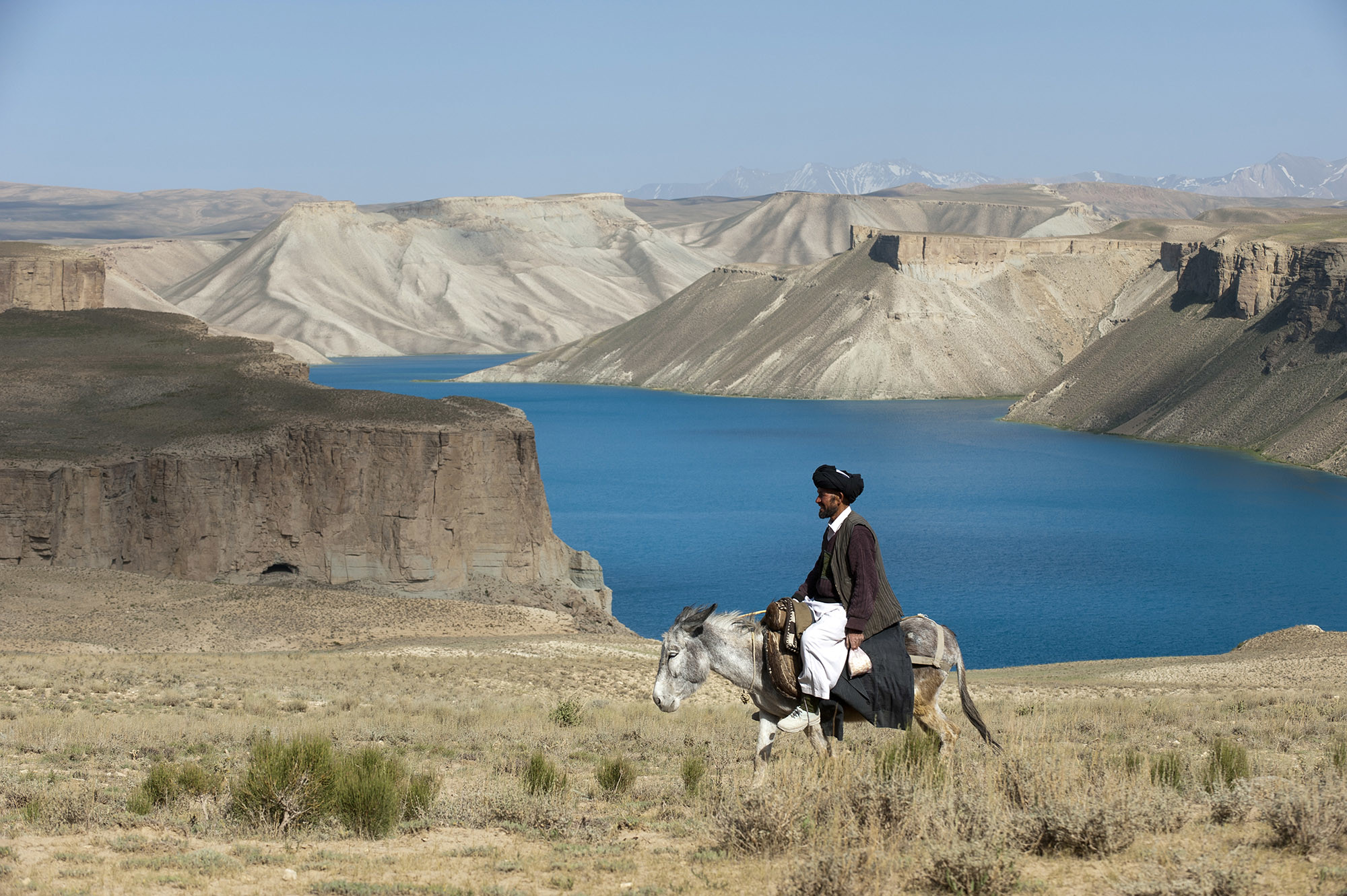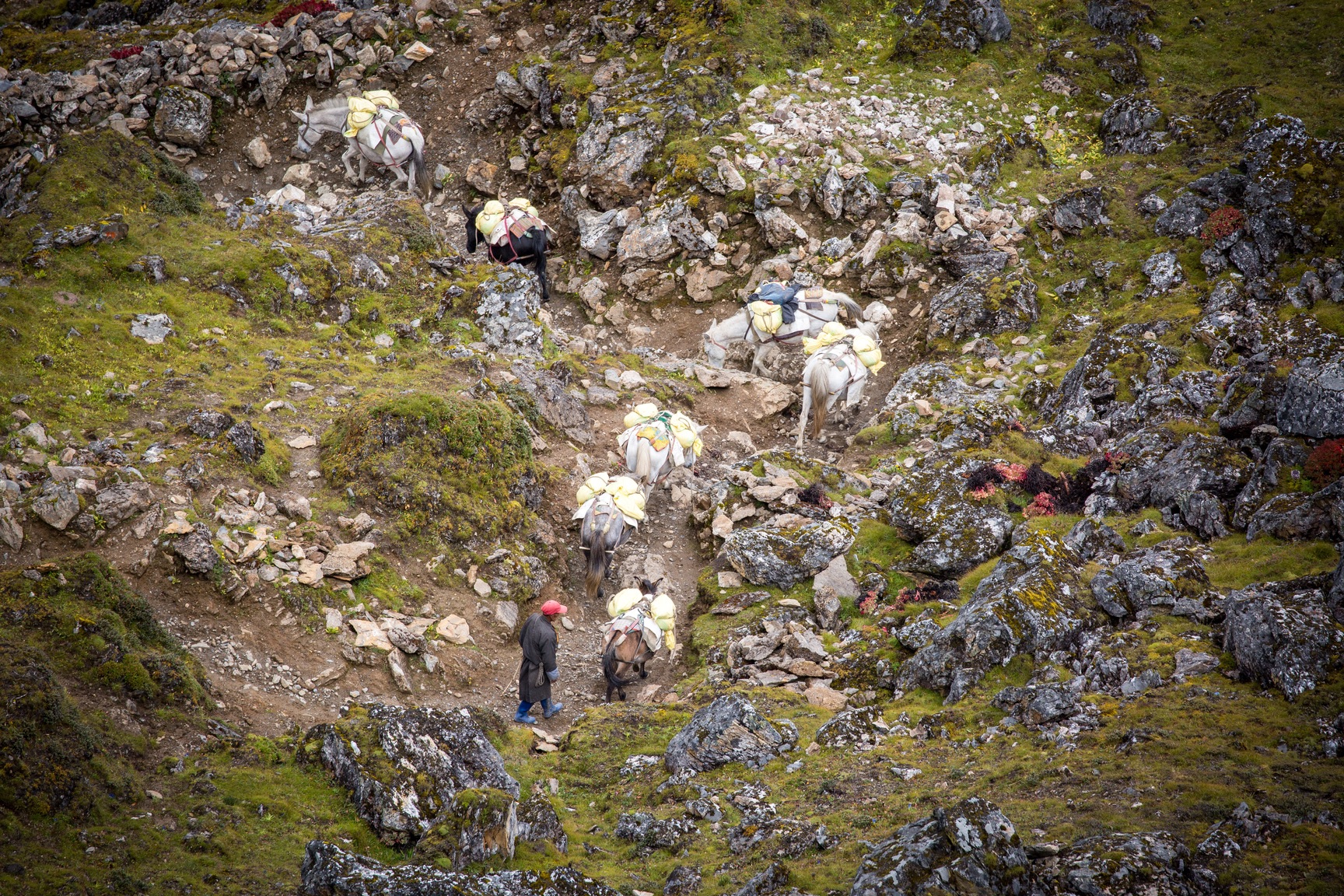Opinion
Restoring mountain ecosystems in the Himalayas is a global Imperative
The Hindu Kush Himalaya faces a critical need for the restoration of its diverse ecosystems, underpinned by the indispensable stewardship of Indigenous communities and local efforts

Freshwater ecosystems such as lakes, rivers, and wetlands – like these in Band-e Amir National Park, Afghanistan – provide an array of services important to livelihoods, economic development and environmental resilience. (Image: Alex Treadway / ICIMOD, CC BY-NC)
Bandana Shakya
May 25, 2024
Mountain ecosystems, including rangelands, wetlands, peatlands and both alpine and temperate forests, are unique habitats characterised by complex geography and rich biodiversity. These ecosystems are integral to the cultures and traditions of diverse Indigenous communities, providing essential goods and services such as food, water, climate regulation and cultural aesthetics. Despite their high economic value, they face profound challenges, primarily driven by global and local changes.
The degradation of mountain ecosystems poses a direct threat to the sustained provision of crucial goods and services. There is an urgent need for the policy community, national governments, regional bodies and the private sector to come together and significantly invest in the restoration of mountain ecosystems in the Hindu Kush Himalaya (HKH). While there are several commendable efforts underway, they are not sufficient to address the magnitude and complexity of the challenges at hand. Additionally, there is a global movement to bring mountain-related issues to the forefront of international discourse and to forge robust global partnerships for mountain ecosystems.
Outlined below are key policy priorities for the HKH:
Strengthening Indigenous stewardship: Indigenous peoples and local communities (IPLCs) have been the traditional stewards of these vital resources. Existing practices, including payment for ecosystem services, have incentivised efforts to preserve upstream ecosystem integrity, benefiting downstream areas. Further incentivising landscape practices rooted in traditional ecological knowledge is crucial for securing the rights of local communities and enhancing their leadership and ownership. Supporting slow food movements and ethnic cuisines, along with strengthening herder networks are essential. Efforts to secure conservation corridors, community-conserved areas and other effective area-based conservation measures (OECMs) are key for promoting IPLC-led inclusive landscape governance.

A herding community, with their pack animals, traverses the rocky and rugged paths of Bhutan’s Laya landscape. This journey highlights the challenging terrain and the traditional modes of transportation that are integral to the region. (Image: Jitendra Bajracharya / ICIMOD)
Scaling nature-based solutions (NbS): NbS such as forest rehabilitation, nature tourism, rangeland restoration and springshed management are long-term integrated solutions that must be scaled up to generate climate, biodiversity and sustainable development co-benefits. The Himalayan Resilience Enabling Action Programme under the Climate Action for Resilient Asia (CARA) initiative is working to scale these solutions to match the rate of degradation and address societal challenges related to water, livelihoods and disaster risk.
Innovating for biodiversity and sustainability: Mechanisms such as payments for ecosystem services, biodiversity grants and impact investments need to be both inclusive and fair to empower local communities and attract private sector engagement. Government incentives, tax credits and green bonds could further stimulate sustainable and inclusive practices. It is imperative to explore innovative policy and financing avenues to ensure the vitality of mountain ecosystems for future generations and balance environmental preservation with socio-economic development.
Global partnerships investments and pooling resources
The recently adopted Kunming-Montreal Global Biodiversity Framework emphasises the urgent need for increased financial investment in biodiversity actions. However, the current level of global financing for nature, and particularly for mountain biodiversity investment, remains inadequate. To enhance overall climate resilience, biodiversity conservation and sustainable development for both mountain and downstream communities, it is crucial to boost investments in mountain ecosystems and expand the scope of community-driven actions.
Cross-learning among countries and the sharing of best practices are essential strategies for building and expanding partnerships aimed at mobilising financial resources. The Hindu Kush Himalaya (HKH) Call to Action, endorsed by a ministerial declaration signed by the eight relevant countries, plays a pivotal role in reinforcing regional cooperation for mountain areas and facilitating collaborative actions to tackle transboundary issues such as climate change, biodiversity loss, pollution, poverty and landscape degradation. The success of such initiatives hinges on the collaborative efforts of governments, non-governmental agencies, the private sector, local communities and international development partners to come together and pool their resources to amplify their joint efforts.

A red panda perched in a tree. The Hindu Kush Himalayan region (HKH) is an important biodiversity hotspot. (Image: Jitendra Raj Bajracharya / ICIMOD, CC BY-NC)
Making the business case for mountain ecosystems
The economic case for conservation: Mountains, recognised as biodiversity hotspots, are crucial for the preservation of Earth’s biological richness. Adopting knowledge-based approaches for biodiversity mapping, monitoring and valuation is essential. These methods provide crucial insights that can drive the adoption of NbS. Economic valuation and natural capital accounting are key tools that can inform investment decisions and help allocate more resources towards the conservation of mountain landscapes, particularly those maintained by IPLCs.
Environmental resilience: Mountain ecosystems serve as systemic enablers that foster positive relationships between nature and people. High-altitude rangelands, peatlands and wetlands play a significant role in climate-related decision-making and investments aimed at reducing greenhouse gas emissions, especially given their role as carbon sinks. Strategic investments are needed to highlight the link between mountain ecosystems and essential resources like food, water and energy security. Moreover, there is a need for incentives to expand mechanisms that prevent human-wildlife conflicts and enhance capacities, as well as to support innovative sustainable land-use practices. These efforts are fundamental in maintaining the ecological balance and ensuring the resilience of these environments
The Hindu Kush Himalaya faces a critical need for the restoration of its diverse ecosystems, underpinned by the indispensable stewardship of Indigenous communities and local efforts

Freshwater ecosystems such as lakes, rivers, and wetlands – like these in Band-e Amir National Park, Afghanistan – provide an array of services important to livelihoods, economic development and environmental resilience. (Image: Alex Treadway / ICIMOD, CC BY-NC)
Bandana Shakya
May 25, 2024
Mountain ecosystems, including rangelands, wetlands, peatlands and both alpine and temperate forests, are unique habitats characterised by complex geography and rich biodiversity. These ecosystems are integral to the cultures and traditions of diverse Indigenous communities, providing essential goods and services such as food, water, climate regulation and cultural aesthetics. Despite their high economic value, they face profound challenges, primarily driven by global and local changes.
The degradation of mountain ecosystems poses a direct threat to the sustained provision of crucial goods and services. There is an urgent need for the policy community, national governments, regional bodies and the private sector to come together and significantly invest in the restoration of mountain ecosystems in the Hindu Kush Himalaya (HKH). While there are several commendable efforts underway, they are not sufficient to address the magnitude and complexity of the challenges at hand. Additionally, there is a global movement to bring mountain-related issues to the forefront of international discourse and to forge robust global partnerships for mountain ecosystems.
Outlined below are key policy priorities for the HKH:
Strengthening Indigenous stewardship: Indigenous peoples and local communities (IPLCs) have been the traditional stewards of these vital resources. Existing practices, including payment for ecosystem services, have incentivised efforts to preserve upstream ecosystem integrity, benefiting downstream areas. Further incentivising landscape practices rooted in traditional ecological knowledge is crucial for securing the rights of local communities and enhancing their leadership and ownership. Supporting slow food movements and ethnic cuisines, along with strengthening herder networks are essential. Efforts to secure conservation corridors, community-conserved areas and other effective area-based conservation measures (OECMs) are key for promoting IPLC-led inclusive landscape governance.

A herding community, with their pack animals, traverses the rocky and rugged paths of Bhutan’s Laya landscape. This journey highlights the challenging terrain and the traditional modes of transportation that are integral to the region. (Image: Jitendra Bajracharya / ICIMOD)
Scaling nature-based solutions (NbS): NbS such as forest rehabilitation, nature tourism, rangeland restoration and springshed management are long-term integrated solutions that must be scaled up to generate climate, biodiversity and sustainable development co-benefits. The Himalayan Resilience Enabling Action Programme under the Climate Action for Resilient Asia (CARA) initiative is working to scale these solutions to match the rate of degradation and address societal challenges related to water, livelihoods and disaster risk.
Innovating for biodiversity and sustainability: Mechanisms such as payments for ecosystem services, biodiversity grants and impact investments need to be both inclusive and fair to empower local communities and attract private sector engagement. Government incentives, tax credits and green bonds could further stimulate sustainable and inclusive practices. It is imperative to explore innovative policy and financing avenues to ensure the vitality of mountain ecosystems for future generations and balance environmental preservation with socio-economic development.
Global partnerships investments and pooling resources
The recently adopted Kunming-Montreal Global Biodiversity Framework emphasises the urgent need for increased financial investment in biodiversity actions. However, the current level of global financing for nature, and particularly for mountain biodiversity investment, remains inadequate. To enhance overall climate resilience, biodiversity conservation and sustainable development for both mountain and downstream communities, it is crucial to boost investments in mountain ecosystems and expand the scope of community-driven actions.
Cross-learning among countries and the sharing of best practices are essential strategies for building and expanding partnerships aimed at mobilising financial resources. The Hindu Kush Himalaya (HKH) Call to Action, endorsed by a ministerial declaration signed by the eight relevant countries, plays a pivotal role in reinforcing regional cooperation for mountain areas and facilitating collaborative actions to tackle transboundary issues such as climate change, biodiversity loss, pollution, poverty and landscape degradation. The success of such initiatives hinges on the collaborative efforts of governments, non-governmental agencies, the private sector, local communities and international development partners to come together and pool their resources to amplify their joint efforts.

A red panda perched in a tree. The Hindu Kush Himalayan region (HKH) is an important biodiversity hotspot. (Image: Jitendra Raj Bajracharya / ICIMOD, CC BY-NC)
Making the business case for mountain ecosystems
The economic case for conservation: Mountains, recognised as biodiversity hotspots, are crucial for the preservation of Earth’s biological richness. Adopting knowledge-based approaches for biodiversity mapping, monitoring and valuation is essential. These methods provide crucial insights that can drive the adoption of NbS. Economic valuation and natural capital accounting are key tools that can inform investment decisions and help allocate more resources towards the conservation of mountain landscapes, particularly those maintained by IPLCs.
Environmental resilience: Mountain ecosystems serve as systemic enablers that foster positive relationships between nature and people. High-altitude rangelands, peatlands and wetlands play a significant role in climate-related decision-making and investments aimed at reducing greenhouse gas emissions, especially given their role as carbon sinks. Strategic investments are needed to highlight the link between mountain ecosystems and essential resources like food, water and energy security. Moreover, there is a need for incentives to expand mechanisms that prevent human-wildlife conflicts and enhance capacities, as well as to support innovative sustainable land-use practices. These efforts are fundamental in maintaining the ecological balance and ensuring the resilience of these environments
.
RECOMMENDEDCan the Himalayan region go green as economies flounder?
Sustainable development: Mountain ecosystems in the Himalayas are fundamental to the traditional livelihoods of mountain communities, offering vast potential for driving green economies. Initiatives from organic agriculture to ecotourism and renewable energy harness these ecosystems’ unique attributes to promote sustainable economic growth. Recognising mountain ecosystems as engines of sustainable development can bolster prosperity both within and beyond these regions, boost the global economy and help attain the United Nations Sustainable Development Goals (UN SDGs).
As we progress through this UN decade on ecosystem restoration, there is a clear urgency for substantial global investment and incentives dedicated to the restoration of HKH ecosystems. Restoring these ecosystems is not just a regional concern but a global imperative. These ecosystems provide not only measurable benefits but also hold immense intrinsic and existential value. Their preservation is crucial for maintaining the natural heritage and cultural significance that enrich our global community.
Innovative financing mechanisms, blending public and private finance, along with other incentive measures, are essential for the effective restoration and regeneration of critical ecosystems in the HKH. Let us act collectively to ensure the resilience of mountain economies and landscapes, from which benefits flow into river basins downstream and extend to the global community at large.
The author is coordinator for the Action Area on Restoring and Regenerating Landscapes at the International Centre for Integrated Mountain Development (ICIMOD). The views expressed are her own

RECOMMENDEDCan the Himalayan region go green as economies flounder?
Sustainable development: Mountain ecosystems in the Himalayas are fundamental to the traditional livelihoods of mountain communities, offering vast potential for driving green economies. Initiatives from organic agriculture to ecotourism and renewable energy harness these ecosystems’ unique attributes to promote sustainable economic growth. Recognising mountain ecosystems as engines of sustainable development can bolster prosperity both within and beyond these regions, boost the global economy and help attain the United Nations Sustainable Development Goals (UN SDGs).
As we progress through this UN decade on ecosystem restoration, there is a clear urgency for substantial global investment and incentives dedicated to the restoration of HKH ecosystems. Restoring these ecosystems is not just a regional concern but a global imperative. These ecosystems provide not only measurable benefits but also hold immense intrinsic and existential value. Their preservation is crucial for maintaining the natural heritage and cultural significance that enrich our global community.
Innovative financing mechanisms, blending public and private finance, along with other incentive measures, are essential for the effective restoration and regeneration of critical ecosystems in the HKH. Let us act collectively to ensure the resilience of mountain economies and landscapes, from which benefits flow into river basins downstream and extend to the global community at large.
The author is coordinator for the Action Area on Restoring and Regenerating Landscapes at the International Centre for Integrated Mountain Development (ICIMOD). The views expressed are her own
No comments:
Post a Comment